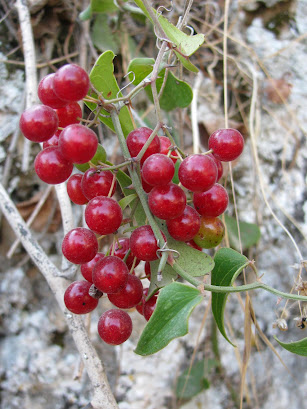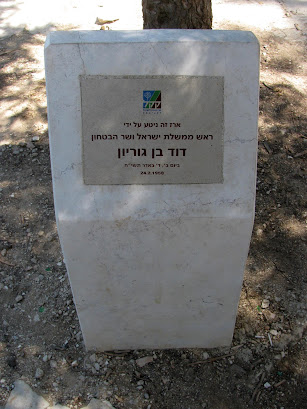Trees planted included pine (Oren), cypress (Brosh matzue) and cedar (Erez). These trees grow very quickly and they rapidly achieved the function they were intended for. However, it subsequently became apparent that pine in particular is not ideal for forests. It has a shallow root system and the cones and trees readily burn. Arson and accidents can destroy a forest. More recent afforestation in the country now uses a variety of trees, especially those indigenous to the country.

Many years have passed since the forest was first planted and Jerusalem has expanded enormously. Large neighbourhoods and suburbs - Ein Kerem, Beit Zayit, Givat Shaul, Kiryat Yovel, Beit HaKerem, Har Nof, Motza - have encroached deep into the forest, as have two important national monuments - Yad Vashem and Herzl's Tomb. The boundaries of the forest have receded and its area now covers only 1,250 dunam. But the forest is easily accessible to the general public and footpaths have been marked out, signposts have been provided, picnic tables and children's playgrounds have been built. The forest has a variety of trees, flowers and wildlife, remains of ancient farming implements and burial caves, wine presses and cisterns that attest to the habitation of the region long ago. One may often see gazelles running in the area and hear the sounds of the numerous songbirds. It's a great place to hike.
Mister Handmade in Israel and I recently followed Shvil HaErez (The Cedar Trail) within the forest. The circular trail was around six kilometres long and the walk took us approximately two and a half hours. The route is signposted and indicated by blue trail markings all the way. It lead us first through an area of forest comprising both planted conifers and Mediterranean woodland trees such as Palestine oak, terebinth, carob, olive, fig and pomegranate. The path continued to climb up a slope, though a forest of pine and cypress trees, eventually leaving the valley and climbing a steep slope until it reached the road. On the other side of the road was Australia Park, a recreation area which is actually the real starting point of the Cedar Trail.
Continuing on, we passed agricultural terraces planted with fruit trees and an olive grove. In the spring, orchids such as the the Anatolian orchid with its red-spotted leaves, peep out from among the bushes, along with anemones, daffodils and cyclamens. The path lead us past a eucalyptus grove, a cave from which an impressive fig tree emerges and, deviating slightly from the path, to a small plaza where Ben Gurion's Cedar grows, below. David Ben Gurion, Israel's first Prime Minister, planted it with his own hands on 2nd February 1958. Admittedly, it is not overwhelming!
From here we made another brief detour from the path and climbed up to Mitzpeh Kerem, the Kerem Viewpoint. Its Arabic name is Khirbet Hamame, which means "Dove Ruins". This hill has been a site of habitation since the Bronze Age and throughout the years has held great strategic importance. We walked past trenches dug by the Ottoman Turks in the First World War as they took up positions ready to confront the British troops, below. During Israel's War of Independence the hill was occupied by Arab forces that fired on the neighbourhoods of Beit Hakerem and Bayit Vegan below. On 10th July 1948 this vantage point was successfully captured by the Jonathan Platoon (Plugat Yehonatan) of the Gadna (the Youth Battalions), a group of fighters too young to be drafted but recruited because of a shortage of fighters to relieve the besieged city of Jerusalem. Six combatants, two of whom were 16 year-old privates, fell in the fighting and dozens of others were injured.
Mitzpeh Kerem was supposed to offer magnificent views that include, among other sites, Yad VaShem's Valley of the Communities, Pilots' Hill (Har HaTayyasim), Eitanim and Ein Kerem's Hadassah Hospital. Unfortunately tree branches blocked the view and it was hard to see very much at all.
We returned to Ben Gurion's Cedar and from there made our way back to the blue-marked trail, which descended through the forest to the main road and back to our car. We had enjoyed beautiful views of parts of Jerusalem and the surrounding wooded hills. It had been pleasant to walk through the forest and woodland scenery but the fact that the forest is so near to the centre of town and that so many neighbourhoods can be seen from the trail, made it feel a little bit like I was still in the city instead of far from the madding crowd.


* This post has been shared on Nature Notes, The Good. The Random. The Fun., Wordless Wednesday (on Tuesday), Our World Tuesday, Tuesday's Treasures, Pictorial Tuesday and My Corner of the World.











































16 comments:
Trees are so important to eco systems. They're our friends for sure. One of the first things my brother-in-law's mother taught us when she joined the family was planting a tree in Israel.
What an amazing hike! It's so amazing what Israel has done with trees!
Beautiful trees and surroundings!
What a lovely hike! #MMBC
What a wonderful place to have on your doorstep. Here's to many more trees! xx
Fascinating history, and a beautiful place to hike, I feel sure.
Here is the US we celebrate Thanksgiving on Thursday. Among many things, I am thankful for our "cyberfriendship". Thanks for joining us this week at https://image-in-ing.blogspot.com/2020/11/sleepy-head.html
Thank you for sharing this interesting Post. The trees are wonderful.
Happy
I enjoyed following you on your walk through the forest. It is important for us all to have green areas that we can escape to from busy city life.
What a lovely trail!
Its indeed remarkable that you have so much trees in your country.Must be a very fine walk with that in mind.
...over the years I have heard about the tree planting programs, what a wonderful thing. The best time to plant a tree was years ago, the next best time is today! Thanks for coming to the party, take care.
That's a very historic forest. I hope it lives into eternity. It was kind of purchased with blood in a way.
Very interesting post and what a nice forest ! I wished I could walk in there, the trees must smell very nice !
Nice trail and beautiful forest. Thanks for sharing your hike with us. #MCoW
A lovely hike, Lisa. This is a great time to be hiking, with the wild flowers beginning to come out after the rain.
Amalia
xo
I'm so glad you took us along on your walk! The scenery is gorgeous and it looks so peaceful.
What a fantastic addition to 'My Corner of the World' this week!
Post a Comment